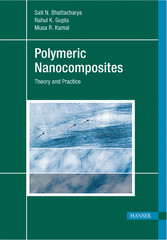Sati N. Bhattacharya, Musa R. Kamal, Rahul K. Gupta
Polymeric Nanocomposites
Theory and Practice
Preface
6
Table of Content
8
1 Introduction
14
1.1 Polymer Nanocomposites
14
1.2 Commercial Potential
15
1.3 Book Structure
16
1.4 References
17
2 Preparation and Synthesis
18
2.1 Polymer Nanocomposites
18
2.1.1 Morphology of Polymer-Layered Silicate Nanocomposites
19
2.1.2 Structure of Layered Silicates
20
2.1.3 Organically Modified Clay
22
2.1.4 Formation of Polymer Nanocomposites
23
2.1.5 Effect of Cation Exchange Capacity on Organoclay
24
2.1.6 Effect of Organic Cation Structure on Organoclay
25
2.2 Nanocomposites - Preparation and Synthesis
25
2.2.1 Solution Dispersion
26
2.2.2 In-Situ Polymerization
28
2.2.3 Melt Intercalation
29
2.2.4 Effect of Mixing
33
2.3 Polymer Matrices: Thermoplastics, Thermosets, Elastomers, Natural, and Biodegradable Polymers
35
2.3.1 Thermoplastics
36
2.3.2 Elastomers
40
2.3.3 Thermosets
41
2.3.4 Natural and Biodegradable Polymers
42
References
43
3 Fundamental Issues in Nanocomposite Synthesis
48
3.1 Introduction
48
3.2 Thermodynamics and Interactions
49
3.2.1 General Thermodynamic Relationships
49
3.2.2 Multi-Component Systems
51
3.2.3 Surface Free Energy
56
3.2.4 Types of Interfacial Interactions
58
3.3 Models of Nanocomposites at Equilibrium
66
3.3.1 Introduction
66
3.3.2 Mean-Field, Lattice-Based Model
68
3.3.3 Self-Consistent Field Approach (SFC)
73
3.3.4 Density Functional Theory (DFT)
82
3.4 Mixing in Nanocomposite Synthesis
87
3.4.1 Distributive Mixing
87
3.4.2 Mixing Quality in Nanocomposites
88
3.5 Mechanics of Particle Separation and Agglomerate Dispersion
95
3.5.1 Separation of Spherical Particles
96
3.5.2 Separation of Platelets
98
3.5.3 Peeling and Lap Shearing Models
106
3.5.4 Rupture and Erosion
109
3.6 Mechanism and Kinetics of Polymer Melt Intercalation
113
3.6.1 Intercalation Mechanism
114
3.6.2 Intercalation Kinetics
117
3.7 Crystallization of Polymers in Nanocomposites
122
3.7.1 Crystallization of Polymers
122
3.7.2 Crystalline Structure and Morphology
123
3.7.3 Crystallization Kinetics
126
3.7.4 The Crystalline Structure of PA-6
132
3.7.5 Polymer Crystallization in Nanocomposites
133
3.7.6 Morphological Effects
142
3.8 References
145
4 Rheology of Nanocomposites
158
4.1 Rheology of Multiphase Systems
158
4.2 Rheology of Polymer/Clay Nanocomposites
159
4.3 Recent Studies on Rheology
159
4.4 Measurement Techniques
160
4.4.1 Steady Shear Measurements
160
4.4.2 Dynamic Shear Measurements
161
4.4.3 Extensional Rheology Measurements
163
4.4.4 Measured Parameters
166
4.5 Steady Shear Rheology
167
4.5.1 Steady Shear Rheology of Nanocomposites
167
4.5.2 Shear Thinning Behavior
168
4.5.3 Normal Stress Behavior
169
4.6 Dynamic Rheology
170
4.6.1 Dynamic Rheology of Nanocomposites
172
4.6.2 Percolation Threshold
174
4.6.3 Time-Temperature Superposition
179
4.6.4 Cox-Merz Rule
181
4.7 Non Linear Viscoelastic Properties
181
4.8 Extensional Rheology
183
4.8.1 Fundamentals
183
4.8.2 Extensional Rheology of Nanocomposites
185
4.8.3 Drawing of Molten Monofilament after Extrusion
186
4.9 Rheological Modeling of Nanocomposites
189
4.9.1 Steady Shear Models
190
4.9.2 Viscoelastic Models
196
4.9.3 Extensional Rheology
219
4.10 Summary
225
References
237
5 Processing of Nanocomposites
246
5.1 Introduction
246
5.1 Extrusion
247
5.1.1 Dispersion of Clay
248
5.1.2 Effect of Extruder Types
253
5.1.3 Effect of Processing Conditions
258
5.2 Injection Molding
258
5.2.1 Structural Hierarchy
259
5.2.2 Barrier and Mechanical Properties for Injection Molded Products
264
5.2.3 Microcellular Injection Molding
265
5.3 Blow Molding
268
5.3.1 Barrier Properties of Blow Molded Products
268
5.4 Foaming
270
5.5 Rotational Molding
276
References
278
6 Structure and Properties Characterization
282
6.1 Introduction
282
6.2 Scattering Techniques
283
6.2.1 X-ray Scattering Fundamentals
284
6.2.2 X-Ray Scattering Studies on Polymer Nanocomposites
293
6.2.3 Small Angle Light Scattering (SALS)
301
6.2.4 Small Angle Neutron Scattering (SANS)
310
6.3 Microscopic Techniques
312
6.3.1 Electron Microscopy
312
6.3.2 Electron Microscopy Studies on Polymer Nanocomposites
312
6.4 Spectroscopic Techniques
320
6.4.1 Fourier Transform Infra-Red (FTIR) Spectroscopy
321
6.4.2 Nuclear Magnetic Resonance (NMR)
323
6.4.3 Ultraviolet (UV) Spectroscopy
325
6.5 Chromatography
326
6.6 Solid-State Characterization: Mechanical Testing
328
6.6.1 Mechanical Testing
328
6.6.2 Dynamic Mechanical Analysis (DMA)
330
6.7 Thermal Characterization
333
6.7.1 Differential Scanning Calorimetry (DSC)
333
6.7.2 Thermal Gravimetric Analysis (TGA)
338
6.7.3 Heat Distortion Temperature (HDT)
342
6.7.4 Cone Calorimetry
344
References
348
7 Application of Polymer Nanocomposites
352
7.1 Introduction
352
7.2 Thermoplastics
354
7.2.1 Polyethylene (PE)
355
7.2.2 Polypropylene (PP)
357
7.2.3 Polyamides (PA)
363
7.2.4 Ethylene-Vinyl Acetate (EVA)
367
7.2.5 Polyethylene Terephthalate (PET)
369
7.2.6 Versatile Nanocarbons
370
7.3 Thermosets
371
7.3.1 Polyurethanes (PU)
372
7.3.2 Epoxies
374
7.3.3 Unsaturated Polyesters (UPE)
376
7.3.4 Phenolics
376
7.4 Biodegradable Polymers
378
7.4.1 Polylactide (PLA) and its Nanocomposites
379
7.4.2 Polycaprolactone (PCL)
380
7.4.3 Starch
381
7.5 Final Comments
382
References
384
Index
388
© 2009-2024 ciando GmbH
 Zu Hanser-Fachbuch.de
Zu Hanser-Fachbuch.de
 Warenkorb
Warenkorb
